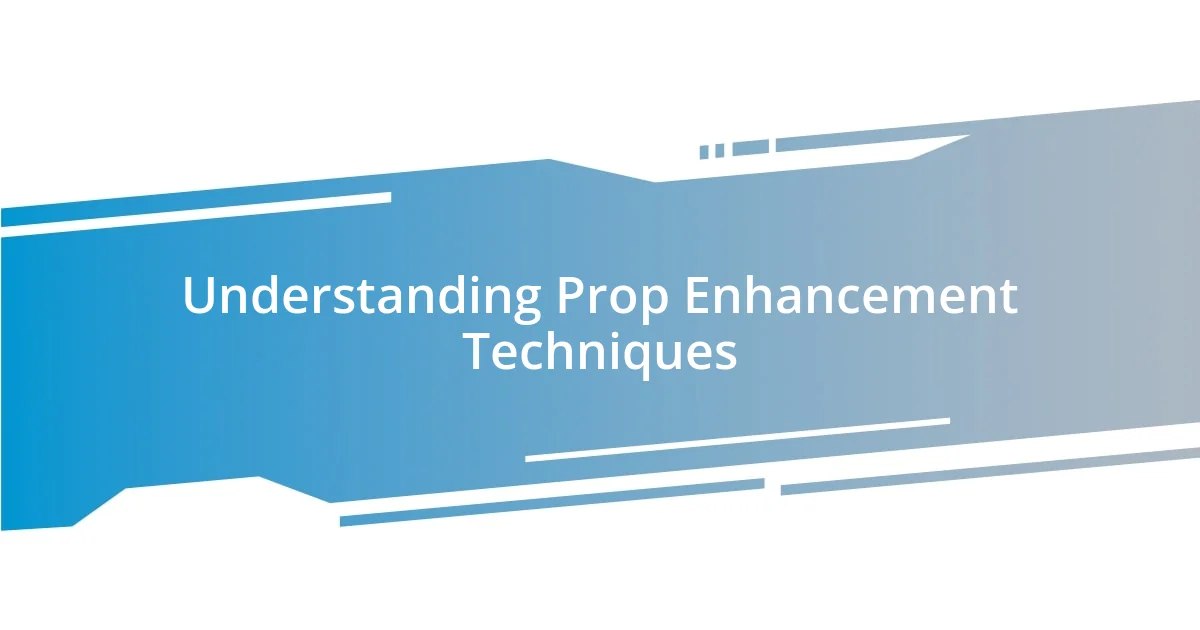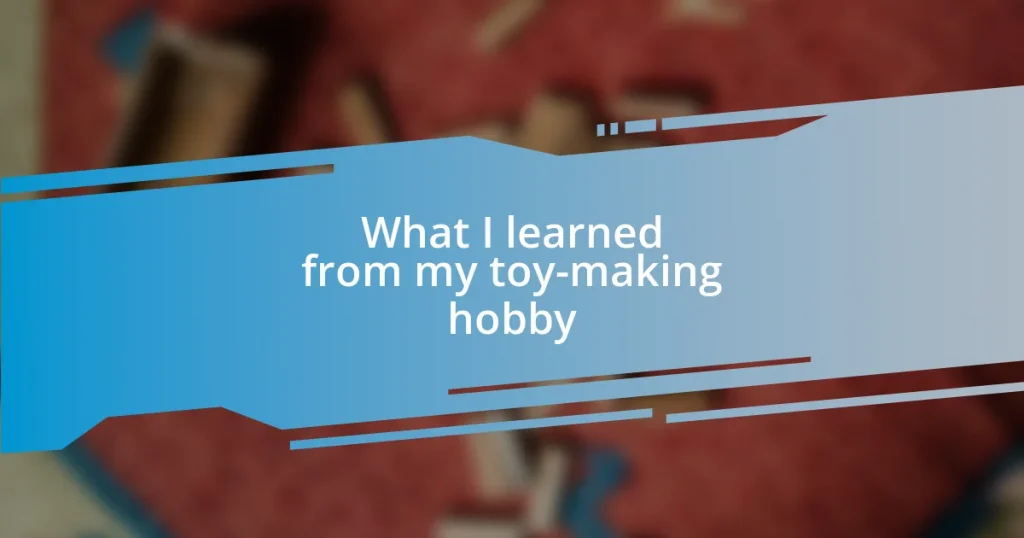Key takeaways:
- Emotional connection can be enhanced through techniques such as color, texture, and lighting, transforming ordinary props into evocative experiences.
- Incorporating diverse materials and tools—like hot glue, airbrush kits, and crafting knives—allows for creative customization and storytelling through props.
- Proper maintenance, including weatherproofing, regular cleaning, and appropriate storage, is essential for preserving the visual impact and longevity of enhanced props.

Understanding Prop Enhancement Techniques
When it comes to enhancing my props, I often think about the emotional connection I want to evoke in my audience. One technique I find particularly effective is the use of color. Color can really transform an ordinary prop into something that resonates with feelings or themes. Have you ever noticed how a simple red flower can symbolize passion, while a blue one may signify tranquility?
Another technique I swear by is texture. I remember a project where I combined different materials – like rough wood paired with smooth glass – and it created such a captivating contrast. The varied surfaces drew people in, inviting them to engage more intimately with the props. How do you think textures influence your perception of objects?
Lastly, lighting plays an enormous role in prop enhancement. I once set up a scene with strategically placed lights that not only highlighted the props but also set a mood, making everything feel more dramatic. It was astonishing to see how the right lighting could evoke different emotions depending on its intensity and color. Isn’t it fascinating how small changes can lead to such powerful reactions?

Materials for Effective Prop Enhancements
When selecting materials for prop enhancements, I often lean towards those that inspire creativity and evoke emotion. For instance, one time I used burlap for rustic charm and combined it with shiny sequins to create a delightful juxtaposition. The result was a beautiful mix of warmth and fun that immediately drew attention and ignited conversation among the audience.
Here are some materials I find particularly effective for enhancing props:
- Foam or Styrofoam: Lightweight and easy to shape, perfect for custom designs.
- Wood: Offers warmth and a natural feel, great for invoking nostalgia.
- Fabric (like velvet or silk): Provides texture and versatility, allowing for dramatic draping.
- Paint (especially spray paint): Ideal for quick color transformation and layering effects.
- LED lights: They add vibrant illumination and can change the mood instantly.
Whenever I incorporate these materials, I can feel the props become more than just objects—they tell a story, evoke memories, and spark imaginations. It truly feels like I’m weaving a tapestry of emotions and experiences, inviting the audience to connect with what they see.

Tools for Prop Customization
When diving into tools for prop customization, I often reflect on the significant impact they have on the final outcome. For more intricate designs, I can’t recommend hot glue guns enough. This tool has saved me countless times—like the time I created a makeshift crown for a theatrical production. The ability to glue various materials together quickly made the process seamless and allowed for adjustments on the fly. Have you ever faced a dilemma in your design that a reliable tool resolved effortlessly?
Moving on to painting tools, I’ve found airbrush kits to be game-changers. The fine control you have with them can turn a simple prop into a work of art, allowing for smooth gradients and detailed designs that normal spray paint just can’t achieve. I recall the excitement I felt while airbrushing a dragon prop; the way the paint glided over the surface was truly mesmerizing. I guess the combination of not just style but the ease of use made the whole creation process feel less like work and more like art!
Lastly, crafting knives are indispensable in my toolkit. They allow for precision cutting, which can be particularly helpful when you want clean edges or intricate designs. I vividly remember slicing through dense foam to create a detailed model for a display. It was almost meditative, the way each cut transformed a flat piece of material into something with depth and character. I often think about how the right tools essentially carry you through your creative journey, don’t you feel the same?
| Tool | Use |
|---|---|
| Hot Glue Gun | Quickly bonds materials, ideal for adjustments |
| Airbrush Kit | Creates smooth gradients and detailed techniques for prop painting |
| Crafting Knife | Offers precision cutting for detailed designs |

Painting Techniques for Props
Painting props can elevate their impact dramatically. One technique I often employ is dry brushing, which involves lightly applying a dry brush to the surface of a painted prop. It can really bring out texture, creating a worn or aged effect. I remember dry brushing a weathered treasure chest for a themed party; the way the highlights showcased the wood grain made it look like a true artifact from a bygone era. Have you ever noticed how a subtle detail can completely change the story a prop tells?
When I want to add depth and dimension, I turn to layering paint. By applying multiple thin coats of different colors, I create a rich, complex look. One of my favorite experiences was layering blues and greens on a mermaid tail I crafted. As I built up the colors, each layer seemed to breathe life into the prop. This process not only enhances the visual appeal but also feels like a dialogue between the materials and my creative vision.
Lastly, I can’t stress enough the importance of using sealers after painting. Not only do they protect the finish, but they also add a professional touch. I once created a large prop for a display, and after sealing it, the colors seemed to pop even more under the lights. It was a proud moment, watching the audience marvel at the prop while I knew it was the careful choice of finishing that made it shine. Have you ever felt that sense of accomplishment when your hard work is finally showcased?

Advanced Lighting for Prop Effects
Lighting can make or break the way props are experienced. I remember working on a haunted house project where I used colored LED lights to create eerie vibes. The way the red and green hues danced across the walls and props added an unsettling depth that completely transformed the space. It’s fascinating how a simple flick of a switch can evoke such strong emotions, don’t you think?
I’ve also explored the beauty of dynamic lighting, utilizing programmable fixtures that change colors and patterns. One time, while preparing for a stage performance, I coordinated a light show that synced to the music. The props seemed alive as they transitioned from a soft blue to a vibrant yellow, adding a theatrical flair that kept everyone at the edge of their seats. This blending of light and prop enhances the storytelling aspect, creating a more immersive experience.
Using projection as a lighting method is another trick in my book. I once designed a prop that featured a flowing ocean scene projected onto its surface. The moving water effect was not just visually striking but also created a mesmerizing backdrop that drew viewers in completely. Have you ever experimented with projection for your projects? The results can be astonishing and deeply engaging!

Texturing Methods for Realism
When it comes to texturing methods for realism, I am a firm believer in the magic of adding physical textures. Think about it—when you run your hands over a surface, the sensations can evoke strong feelings. I once crafted a rock prop for a film set and used a mixture of sand and glue to mimic rough granite. The moment I finished, it felt tangible, almost as if you could hear the crumbling of a quarry. Have you ever touched a prop and imagined the story it helps tell?
Another technique I find effective involves applying mediums to enhance surface details. For instance, I love using plaster or spackle to create uneven surfaces that mimic natural elements. When I was creating an ancient stone wall for a display, I applied layers of the medium before painting, resulting in a beautifully rugged finish. It felt like each bump and crevice was a whisper from history, inviting viewers to explore its narrative. Doesn’t it feel rewarding to know your work can spark curiosity?
Finally, I often incorporate textured paints that contain aggregates—tiny particles embedded in the paint that create incredible effects. I vividly remember painting a prop for a medieval festival and choosing a stone-textured paint. The result was mesmerizing; from a distance, it looked just like real stone. A friend commented on the authenticity, and I realized how these little choices can make such a big difference. Have you ever found a textured finish that just transformed your project from ordinary to extraordinary?

Maintenance Tips for Enhanced Props
Taking care of enhanced props is crucial if you want them to last and maintain their visual impact. I learned this the hard way during a Halloween event when I neglected to weatherproof my outdoor props. After a downpour, those beautifully painted skulls were a washed-out mess. Now, I always use sealants or protective coatings to weatherproof my outdoor displays. What do you do to protect your props from the elements?
Regular cleaning is another essential maintenance tip that can’t be overlooked. I remember visiting a friend’s studio filled with remarkable props that had accumulated dust over time. While they still looked impressive, their charm was dulled. Now, I set aside time after every show to gently clean my props, using soft, damp cloths. This simple act not only keeps them looking new but also helps preserve the intricate details I’ve worked so hard to create. Have you ever noticed how a little upkeep can make a world of difference?
Lastly, I recommend storing props properly to extend their lifespan. For instance, when I finished a big project, I learned to avoid stacking my delicate pieces carelessly in a corner. Instead, I invested in shelving and storage bins, labeling them in a way that makes retrieval easy. The relief of pulling out a well-kept prop for the next event is unmatched. How do you approach storing your creations?
















